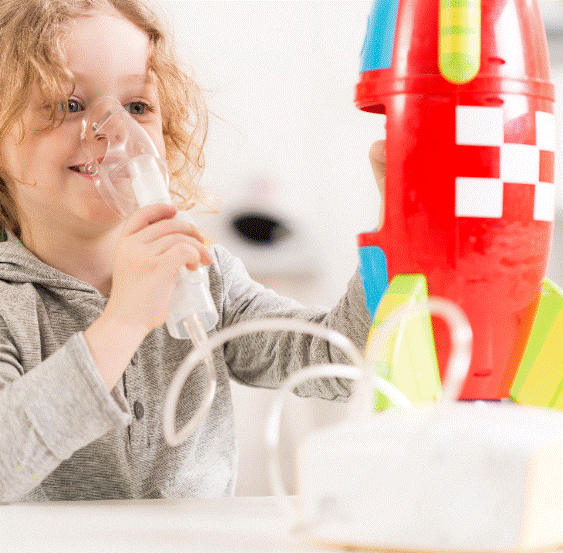Cystic Fibrosis
Cystic fibrosis is an inherited illness causing sticky mucus to build up and damage the lungs, pancreas, and other organs.
In the lungs, mucus traps bacteria, increasing the risk for infections such as pneumonia.
In the pancreas, mucus inhibits the release of enzymes that help the body digest food and absorb nutrients.
Cystic fibrosis is relatively rare. An estimated 30,000 people in the United States and 70,000 people around the world have the disease.
About 1,000 people are newly diagnosed in the United States each year.
CAUSES
Cystic fibrosis is a genetic disease. The inheritance pattern that results in cystic fibrosis is autosomal recessive, which anticipates that a person has to inherit one copy of the damaged gene from each parent to get the disease.
Someone that only inherits one copy of the mutated gene is called a carrier. They will not have symptoms of cystic fibrosis, but they can pass their copy of the mutated gene to their own children.
The defective gene in cystic fibrosis alters the production of a protein called cystic fibrosis transmembrane regulator (CFTR).
The CFTR protein helps salt and water move in and out of cells to keep a normal balance. Having the correct balance of salt and water keeps mucus thin and slippery.
When CFTR proteins are missing or defective, the mucus becomes abnormally thick and sticky. The sweat also becomes extra salty.
Normally, mucus lubricates surfaces such as the airways and gastrointestinal tract.
In cystic fibrosis, the sticky and thick mucus builds up and blocks tubes such as the airways in the lungs and ducts in the pancreas.
In the lungs, the thick mucus traps bacteria, which can lead to repeated infections. These infections can eventually damage the airways.
Mucus also blocks the airways, making it harder to breathe.
In the pancreas, mucus blocks the tubes through which digestive enzymes are released.
These enzymes help break down foods so that the body can absorb the nutrients. A lack of these enzymes can lead to nutrient deficiencies.
Mucus can also block ducts in the liver. That can lead to liver damage and scarring called cirrhosis.
SYMPTOMS
The severity of cystic fibrosis symptoms varies from person to person.
Sometimes symptoms do not appear until late in childhood or adolescence.
Symptoms of cystic fibrosis include:
- a persistent cough that brings up thick mucus
- shortness of breath
- wheezing
- repeated colds and other lung infections
- very salty sweat
- failure to grow or gain weight
- abnormal bowel movements, including foul-smelling and greasy stools
- severe constipation
- rectal prolapse—a condition in which the rectum protrudes through the opening of the anus
Most men with cystic fibrosis are born without the vas deferens, the tube that carries sperm from the testes to the penis.
Without this tube, men are unable to father children.
Cystic fibrosis can also make it harder for women to get pregnant; for example, if mucus blocks the opening to their cervix.
DIAGNOSIS
Infants are routinely screened for cystic fibrosis in the United States. The newborn blood test checks for high levels of an enzyme called immunoreactive trypsin.
This enzyme is produced when the pancreas is damaged.
Another way to test newborns for cystic fibrosis is with a sweat test. The health care provider collects sweat from the child’s arm using a sweat-producing chemical and a mild electric current.
The sweat is collected on a pad, and salt levels are analyzed. Higher than normal levels of salt in the sweat indicates a diagnosis of cystic fibrosis.
Genetic tests for cystic fibrosis are also available. The most common gene mutation related to this disease is called deltaF508 (alternatively known as F508del-CFTR).
At least 70 percent of people with cystic fibrosis have this mutation. Couples can get tested before starting a family to learn their risks of having a child with cystic fibrosis.
TREATMENT
Treatments for cystic fibrosis involve airway clearance therapy to remove sticky mucus from the lungs, medicines to thin mucus, antibiotics to prevent infections, and drugs to help the body absorb more of the nutrients from food.
Airway clearance therapy encompasses several techniques to remove mucus from the lungs.
Huff coughing uses a combination of deep breathing and coughing to loosen mucus so that it can be coughed up.
Percussion involves tapping on the side of the body to dislodge mucus from the airway which is then coughed out of the lungs.
Some people wear an oscillating vest that vibrates at a high frequency to shake mucus free from the airways.
Medicines called mucolytics thin mucus in the lungs. The two main types of mucolytic drugs are hypertonic saline and dornase alfa (Pulmozyme).
You breathe these medicines into your lungs through a device called a nebulizer.
Taking antibiotics routinely can help prevent lung infections. You can take these medicines by mouth or by breathing them in.
Anti-inflammatory medicines help reduce swelling in the airways due to infections.
A relatively new drug called lumacaftor/ivacaftor (Orkambi) is approved for children ages two or older who have two copies of the deltaF508 gene mutation.
Orkambi helps the CFTR protein work more effectively to prevent mucus from becoming thick and sticky.
Treatment is also available for the digestive symptoms of cystic fibrosis. Pancreatic enzyme supplements help people with cystic fibrosis absorb nutrients from the foods they eat.
You take these enzymes before you eat a meal or snack. Your doctor may also recommend taking a multivitamin to make up for any nutritional shortfalls.
Some people may need to eat more salt or take salt supplements to make up for what they sweat out, especially during exercise.
PROGNOSIS
Fifty years ago, cystic fibrosis was a deadly disease. Most children with the condition did not live past elementary school age.
Today, treatments have improved dramatically, and people can live into their 30s or 40s, or even longer with the disease.
The outlook differs depending on the severity of the condition. Some people have a milder version of the disease than others.
Symptoms may worsen with time, and it is possible to develop complications such as chronic infections, permanent lung damage, and nutritional deficiencies.
The earlier one receives the treatment, the better the outcome He can expect.
Resources
Websites
“About cystic fibrosis.” Cystic Fibrosis Foundation. https://www.cff.org/What-is-CF/About-Cystic-Fibrosis/ (accessed December 5, 2018).
“Cystic fibrosis (CF).” American Lung Association. https://www.lung.org/lung-health-and-diseases/lung-disease-lookup/cystic-fibrosis/ (accessed December 5, 2018).
“Cystic fibrosis.” Mayo Clinic. October 13, 2016. https://www.mayoclinic.org/diseases-conditions/cystic-fibrosis/symptoms-causes/syc-20353700 (accessed December 5, 2018).
“Cystic fibrosis.” National Heart, Lung, and Blood Institute. https://www.nhlbi.nih.gov/health-topics/cystic-fibrosis (accessed December 5, 2018).
Organizations
American Lung Association, 55 W. Wacker Drive, Suite 1150, Chicago, IL, 60601, (800) 586-4872, info@lung.org, https://www.lung.org.
Cystic Fibrosis Foundation, 4550 Montgomery Ave., Suite 1100 N, Bethesda, MD, 20814, (800) 344-4823, (301) 951-4422, info@cff.org, https://www.cff.org .
National Heart, Lung, and Blood Institute, 31 Center Drive, Building 31, Bethesda, MD, 20892, (301) 592-8573, nhlbiinfo@nhlbi.nih.gov, https://www.nhlbi.nih.gov.









